Behavioral Finance - Study Material with Solved Assignments
VerifiedAdded on 2022/10/01
|10
|1019
|197
AI Summary
This document provides study material on Behavioral Finance covering topics such as risk aversion, uncertainty, heuristics, and more. It includes solved assignments and essays. The document also explains the four-fold pattern and the concept of certainty equivalence.
Contribute Materials
Your contribution can guide someone’s learning journey. Share your
documents today.
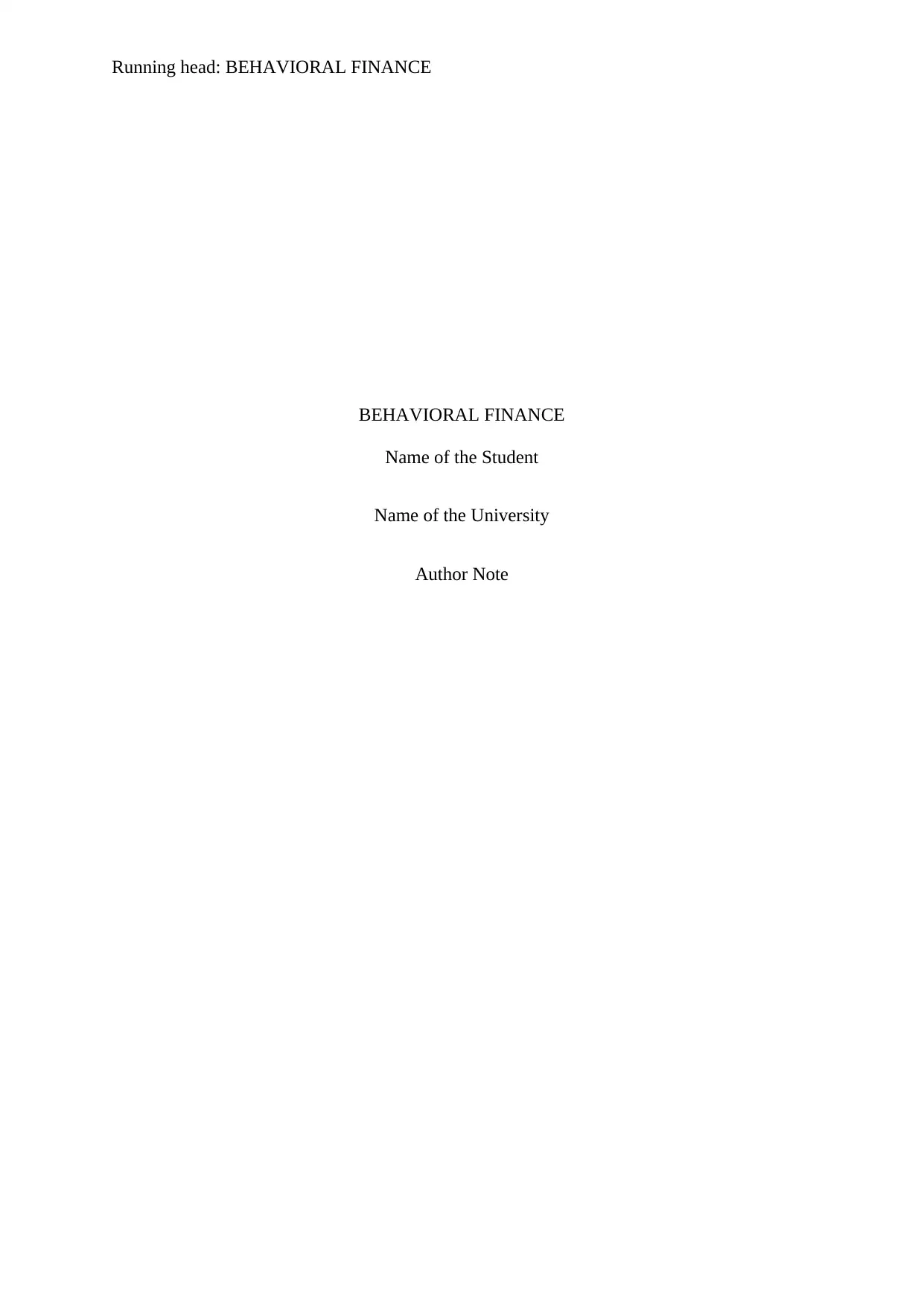
Running head: BEHAVIORAL FINANCE
BEHAVIORAL FINANCE
Name of the Student
Name of the University
Author Note
BEHAVIORAL FINANCE
Name of the Student
Name of the University
Author Note
Secure Best Marks with AI Grader
Need help grading? Try our AI Grader for instant feedback on your assignments.
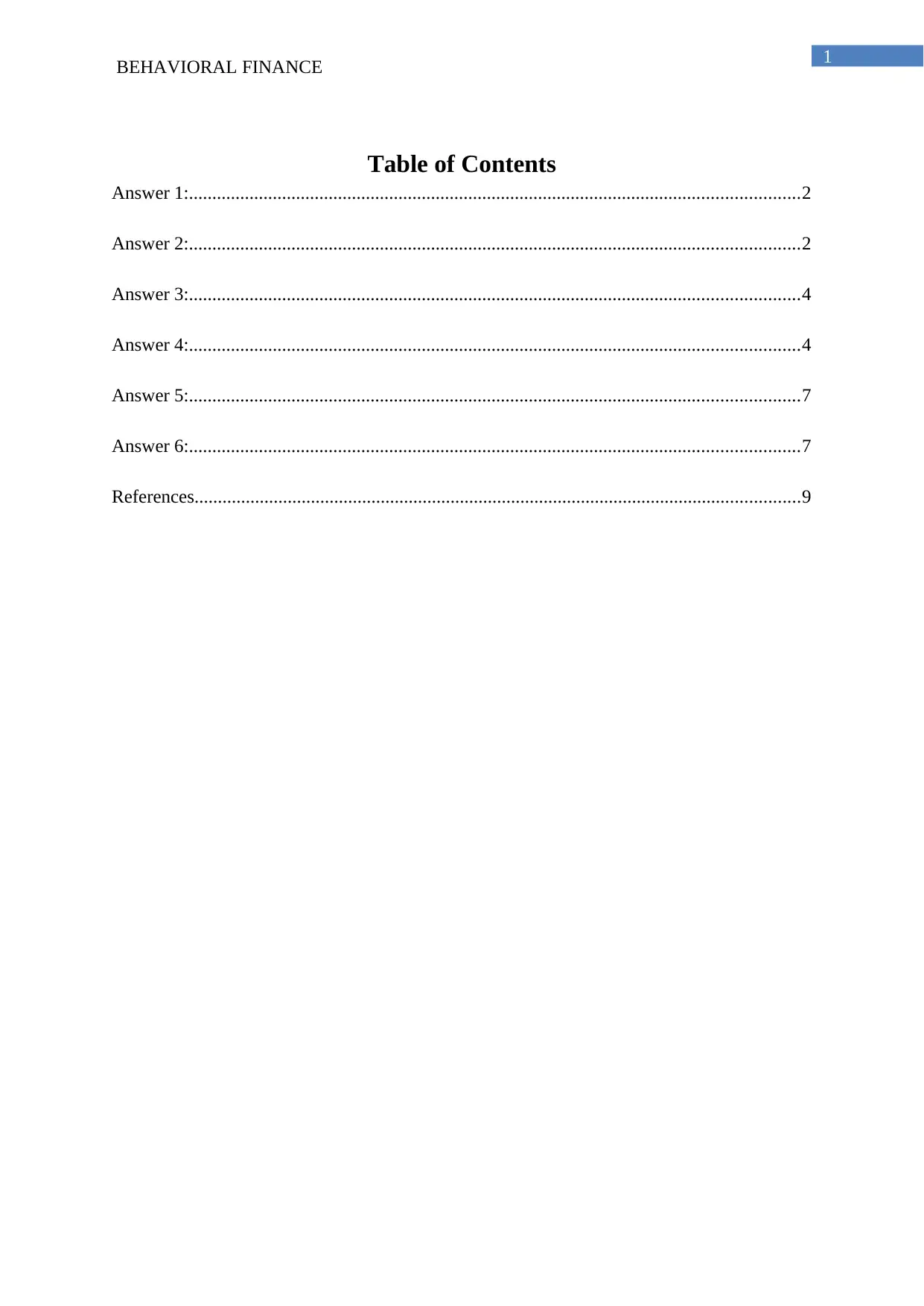
1
BEHAVIORAL FINANCE
Table of Contents
Answer 1:...................................................................................................................................2
Answer 2:...................................................................................................................................2
Answer 3:...................................................................................................................................4
Answer 4:...................................................................................................................................4
Answer 5:...................................................................................................................................7
Answer 6:...................................................................................................................................7
References..................................................................................................................................9
BEHAVIORAL FINANCE
Table of Contents
Answer 1:...................................................................................................................................2
Answer 2:...................................................................................................................................2
Answer 3:...................................................................................................................................4
Answer 4:...................................................................................................................................4
Answer 5:...................................................................................................................................7
Answer 6:...................................................................................................................................7
References..................................................................................................................................9
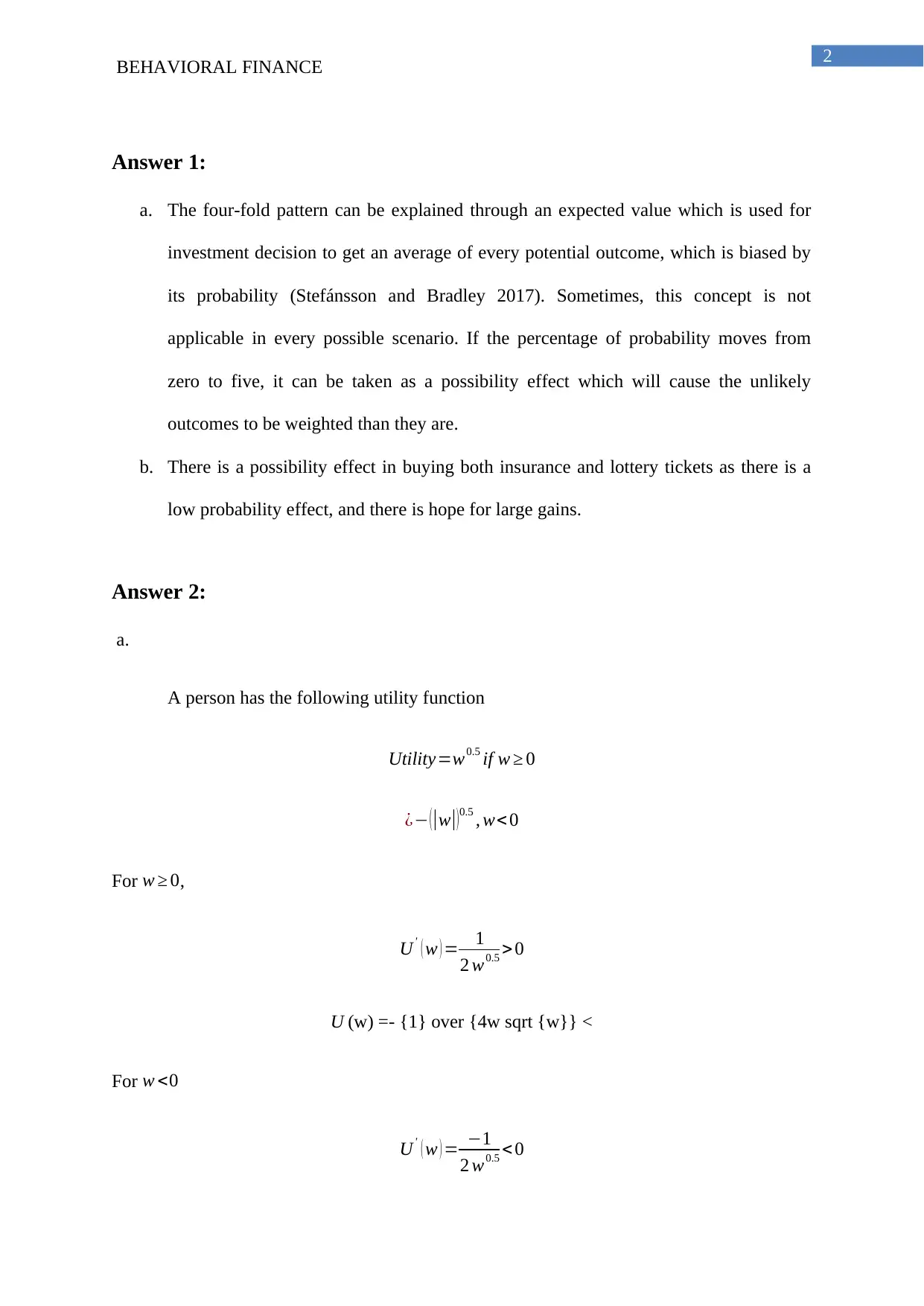
2
BEHAVIORAL FINANCE
Answer 1:
a. The four-fold pattern can be explained through an expected value which is used for
investment decision to get an average of every potential outcome, which is biased by
its probability (Stefánsson and Bradley 2017). Sometimes, this concept is not
applicable in every possible scenario. If the percentage of probability moves from
zero to five, it can be taken as a possibility effect which will cause the unlikely
outcomes to be weighted than they are.
b. There is a possibility effect in buying both insurance and lottery tickets as there is a
low probability effect, and there is hope for large gains.
Answer 2:
a.
A person has the following utility function
Utility=w0.5 if w ≥ 0
¿− (|w|)0.5 , w< 0
For w ≥ 0,
U' ( w ) = 1
2 w0.5 > 0
U (w) =- {1} over {4w sqrt {w}} <
For w <0
U' ( w ) = −1
2 w0.5 < 0
BEHAVIORAL FINANCE
Answer 1:
a. The four-fold pattern can be explained through an expected value which is used for
investment decision to get an average of every potential outcome, which is biased by
its probability (Stefánsson and Bradley 2017). Sometimes, this concept is not
applicable in every possible scenario. If the percentage of probability moves from
zero to five, it can be taken as a possibility effect which will cause the unlikely
outcomes to be weighted than they are.
b. There is a possibility effect in buying both insurance and lottery tickets as there is a
low probability effect, and there is hope for large gains.
Answer 2:
a.
A person has the following utility function
Utility=w0.5 if w ≥ 0
¿− (|w|)0.5 , w< 0
For w ≥ 0,
U' ( w ) = 1
2 w0.5 > 0
U (w) =- {1} over {4w sqrt {w}} <
For w <0
U' ( w ) = −1
2 w0.5 < 0
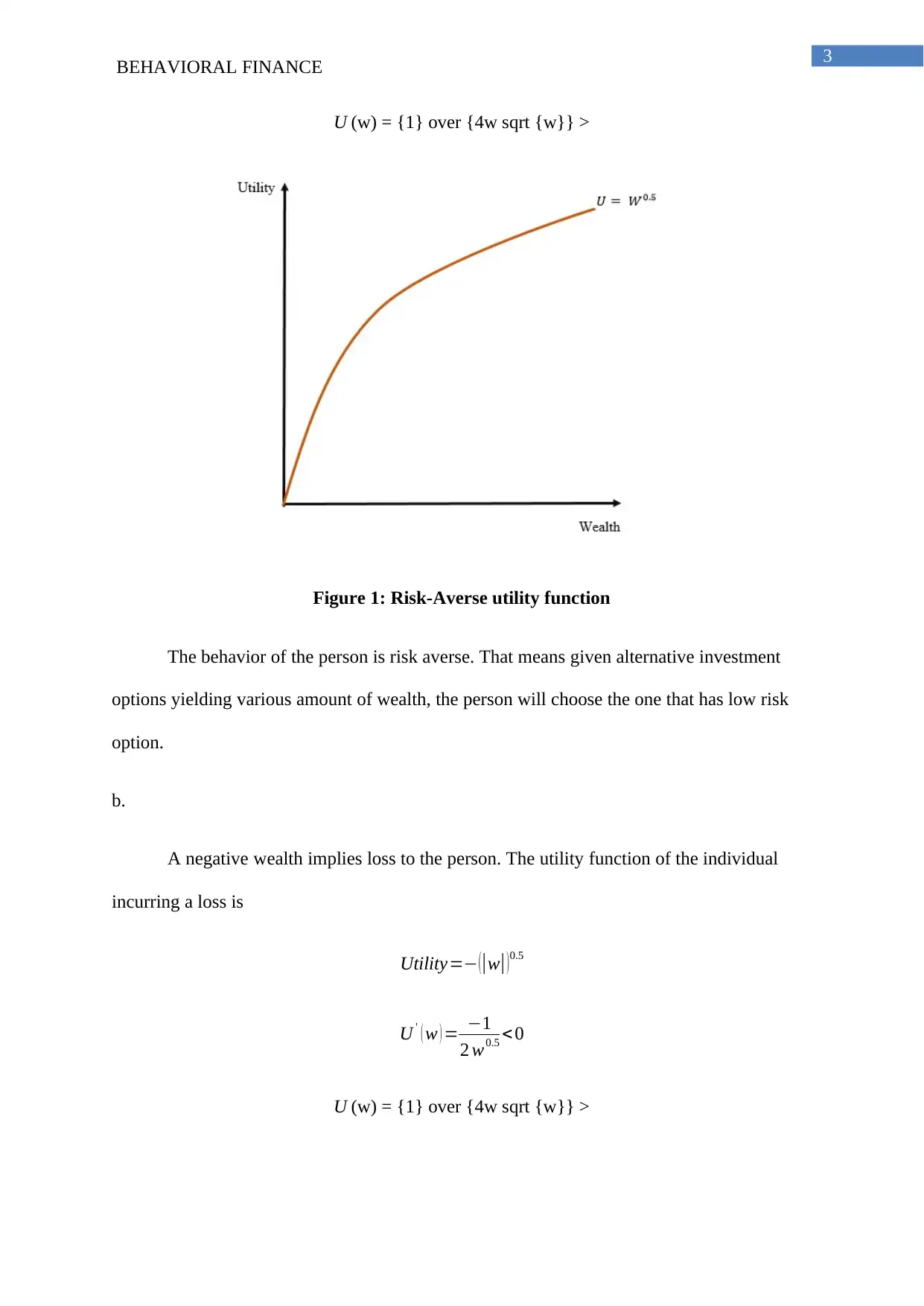
3
BEHAVIORAL FINANCE
U (w) = {1} over {4w sqrt {w}} >
Figure 1: Risk-Averse utility function
The behavior of the person is risk averse. That means given alternative investment
options yielding various amount of wealth, the person will choose the one that has low risk
option.
b.
A negative wealth implies loss to the person. The utility function of the individual
incurring a loss is
Utility=− (|w|) 0.5
U' ( w ) = −1
2 w0.5 < 0
U (w) = {1} over {4w sqrt {w}} >
BEHAVIORAL FINANCE
U (w) = {1} over {4w sqrt {w}} >
Figure 1: Risk-Averse utility function
The behavior of the person is risk averse. That means given alternative investment
options yielding various amount of wealth, the person will choose the one that has low risk
option.
b.
A negative wealth implies loss to the person. The utility function of the individual
incurring a loss is
Utility=− (|w|) 0.5
U' ( w ) = −1
2 w0.5 < 0
U (w) = {1} over {4w sqrt {w}} >
Secure Best Marks with AI Grader
Need help grading? Try our AI Grader for instant feedback on your assignments.
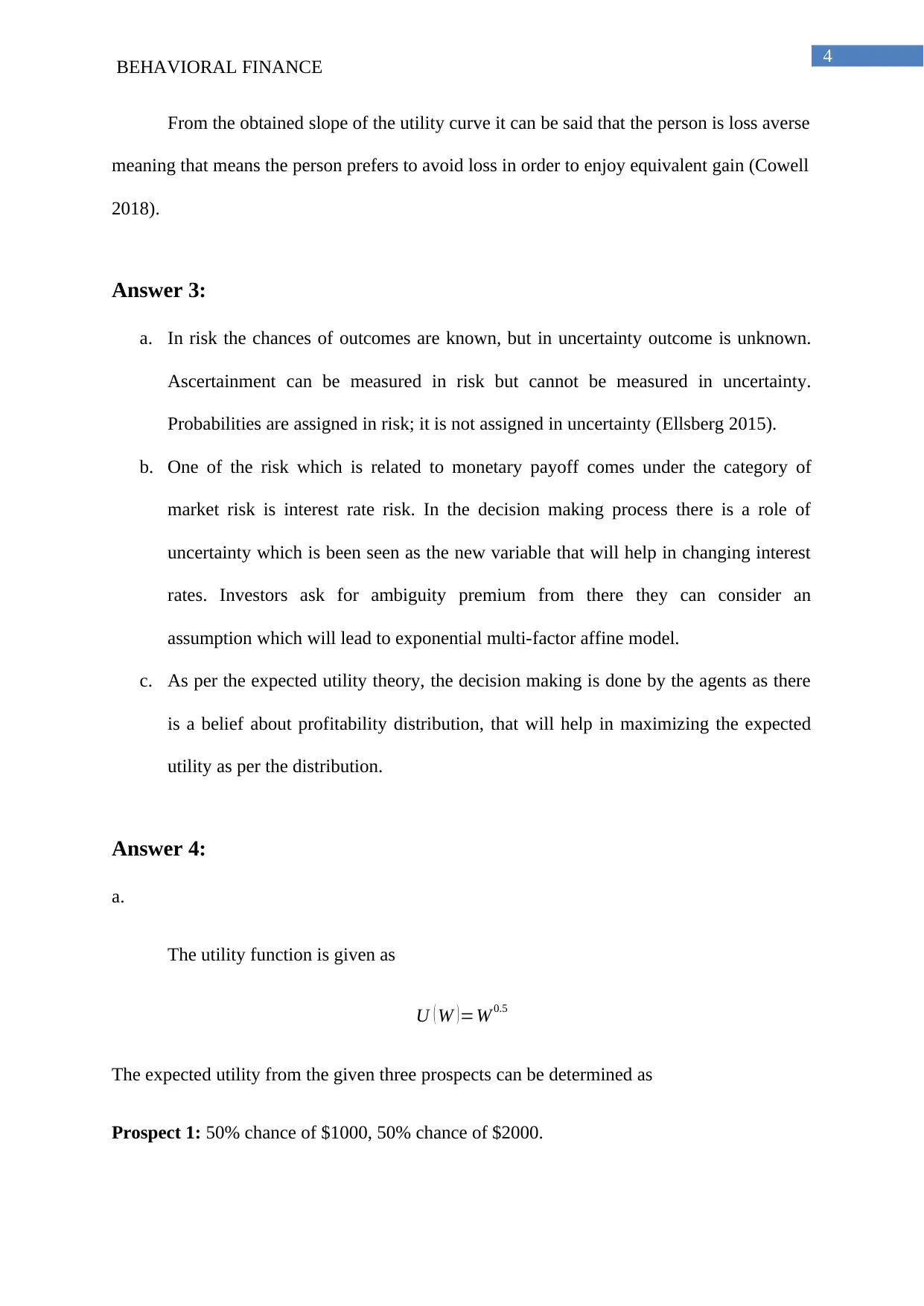
4
BEHAVIORAL FINANCE
From the obtained slope of the utility curve it can be said that the person is loss averse
meaning that means the person prefers to avoid loss in order to enjoy equivalent gain (Cowell
2018).
Answer 3:
a. In risk the chances of outcomes are known, but in uncertainty outcome is unknown.
Ascertainment can be measured in risk but cannot be measured in uncertainty.
Probabilities are assigned in risk; it is not assigned in uncertainty (Ellsberg 2015).
b. One of the risk which is related to monetary payoff comes under the category of
market risk is interest rate risk. In the decision making process there is a role of
uncertainty which is been seen as the new variable that will help in changing interest
rates. Investors ask for ambiguity premium from there they can consider an
assumption which will lead to exponential multi-factor affine model.
c. As per the expected utility theory, the decision making is done by the agents as there
is a belief about profitability distribution, that will help in maximizing the expected
utility as per the distribution.
Answer 4:
a.
The utility function is given as
U ( W ) =W 0.5
The expected utility from the given three prospects can be determined as
Prospect 1: 50% chance of $1000, 50% chance of $2000.
BEHAVIORAL FINANCE
From the obtained slope of the utility curve it can be said that the person is loss averse
meaning that means the person prefers to avoid loss in order to enjoy equivalent gain (Cowell
2018).
Answer 3:
a. In risk the chances of outcomes are known, but in uncertainty outcome is unknown.
Ascertainment can be measured in risk but cannot be measured in uncertainty.
Probabilities are assigned in risk; it is not assigned in uncertainty (Ellsberg 2015).
b. One of the risk which is related to monetary payoff comes under the category of
market risk is interest rate risk. In the decision making process there is a role of
uncertainty which is been seen as the new variable that will help in changing interest
rates. Investors ask for ambiguity premium from there they can consider an
assumption which will lead to exponential multi-factor affine model.
c. As per the expected utility theory, the decision making is done by the agents as there
is a belief about profitability distribution, that will help in maximizing the expected
utility as per the distribution.
Answer 4:
a.
The utility function is given as
U ( W ) =W 0.5
The expected utility from the given three prospects can be determined as
Prospect 1: 50% chance of $1000, 50% chance of $2000.
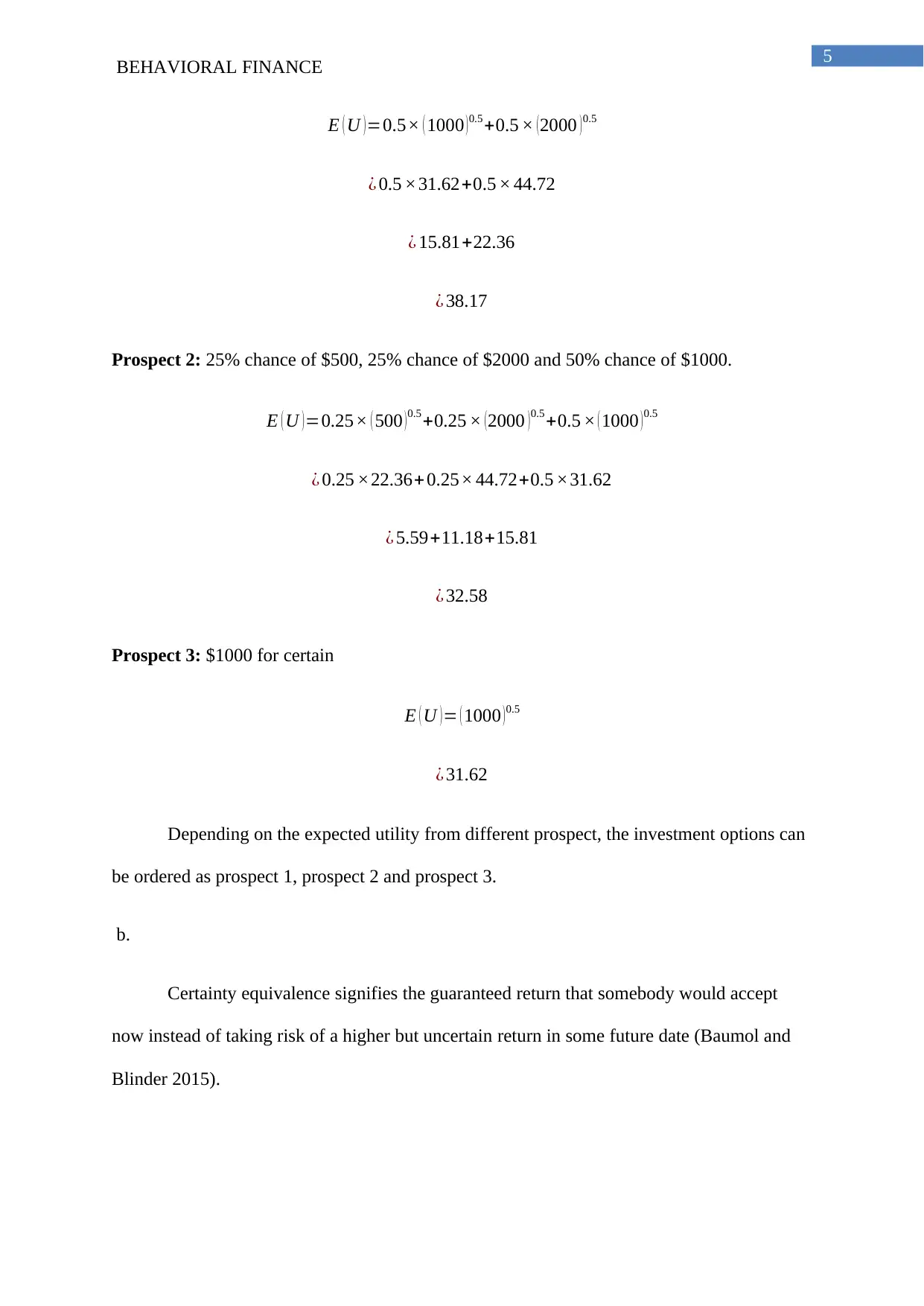
5
BEHAVIORAL FINANCE
E ( U ) =0.5× ( 1000 ) 0.5 +0.5 × ( 2000 ) 0.5
¿ 0.5 ×31.62+0.5 × 44.72
¿ 15.81+22.36
¿ 38.17
Prospect 2: 25% chance of $500, 25% chance of $2000 and 50% chance of $1000.
E ( U )=0.25× ( 500 )0.5 +0.25 × (2000 )0.5+0.5 × ( 1000 )0.5
¿ 0.25 ×22.36+ 0.25× 44.72+0.5 ×31.62
¿ 5.59+11.18+15.81
¿ 32.58
Prospect 3: $1000 for certain
E ( U ) = ( 1000 ) 0.5
¿ 31.62
Depending on the expected utility from different prospect, the investment options can
be ordered as prospect 1, prospect 2 and prospect 3.
b.
Certainty equivalence signifies the guaranteed return that somebody would accept
now instead of taking risk of a higher but uncertain return in some future date (Baumol and
Blinder 2015).
BEHAVIORAL FINANCE
E ( U ) =0.5× ( 1000 ) 0.5 +0.5 × ( 2000 ) 0.5
¿ 0.5 ×31.62+0.5 × 44.72
¿ 15.81+22.36
¿ 38.17
Prospect 2: 25% chance of $500, 25% chance of $2000 and 50% chance of $1000.
E ( U )=0.25× ( 500 )0.5 +0.25 × (2000 )0.5+0.5 × ( 1000 )0.5
¿ 0.25 ×22.36+ 0.25× 44.72+0.5 ×31.62
¿ 5.59+11.18+15.81
¿ 32.58
Prospect 3: $1000 for certain
E ( U ) = ( 1000 ) 0.5
¿ 31.62
Depending on the expected utility from different prospect, the investment options can
be ordered as prospect 1, prospect 2 and prospect 3.
b.
Certainty equivalence signifies the guaranteed return that somebody would accept
now instead of taking risk of a higher but uncertain return in some future date (Baumol and
Blinder 2015).
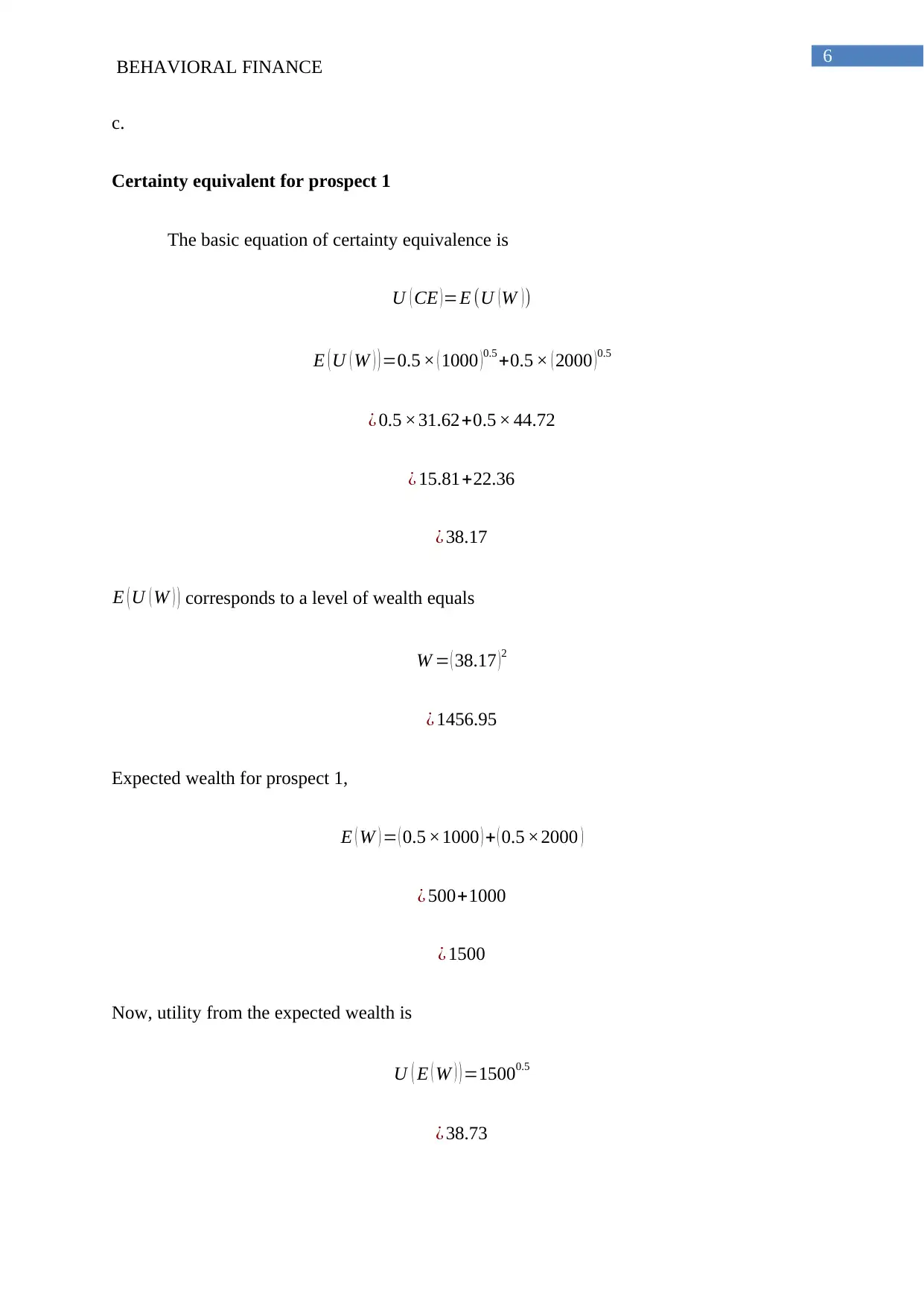
6
BEHAVIORAL FINANCE
c.
Certainty equivalent for prospect 1
The basic equation of certainty equivalence is
U ( CE ) =E (U ( W ) )
E ( U ( W ) ) =0.5 × ( 1000 ) 0.5 +0.5 × ( 2000 ) 0.5
¿ 0.5 ×31.62+0.5 × 44.72
¿ 15.81+22.36
¿ 38.17
E ( U ( W ) ) corresponds to a level of wealth equals
W = ( 38.17 )2
¿ 1456.95
Expected wealth for prospect 1,
E ( W ) = ( 0.5 ×1000 ) + ( 0.5 ×2000 )
¿ 500+1000
¿ 1500
Now, utility from the expected wealth is
U ( E ( W ) ) =15000.5
¿ 38.73
BEHAVIORAL FINANCE
c.
Certainty equivalent for prospect 1
The basic equation of certainty equivalence is
U ( CE ) =E (U ( W ) )
E ( U ( W ) ) =0.5 × ( 1000 ) 0.5 +0.5 × ( 2000 ) 0.5
¿ 0.5 ×31.62+0.5 × 44.72
¿ 15.81+22.36
¿ 38.17
E ( U ( W ) ) corresponds to a level of wealth equals
W = ( 38.17 )2
¿ 1456.95
Expected wealth for prospect 1,
E ( W ) = ( 0.5 ×1000 ) + ( 0.5 ×2000 )
¿ 500+1000
¿ 1500
Now, utility from the expected wealth is
U ( E ( W ) ) =15000.5
¿ 38.73
Paraphrase This Document
Need a fresh take? Get an instant paraphrase of this document with our AI Paraphraser
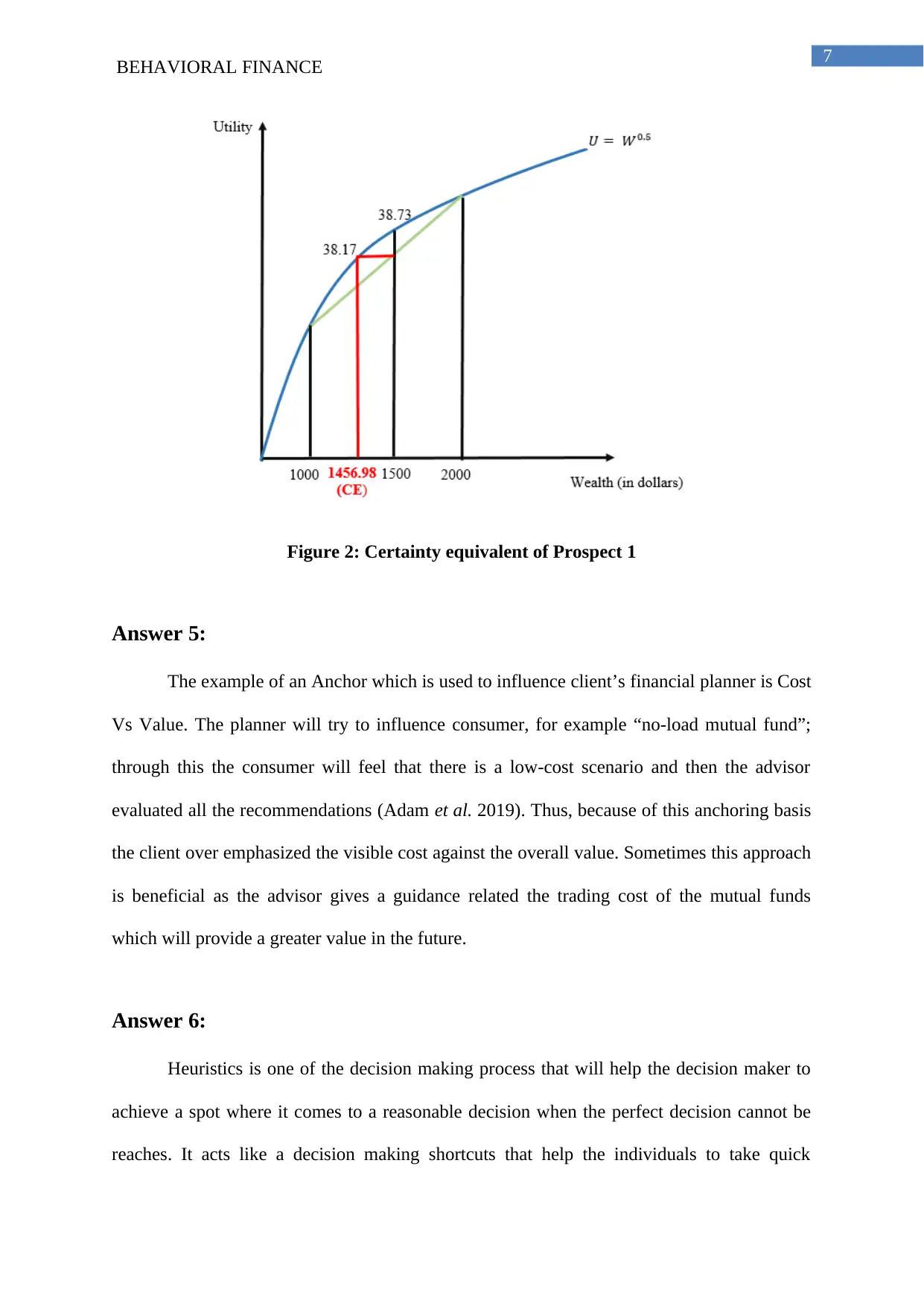
7
BEHAVIORAL FINANCE
Figure 2: Certainty equivalent of Prospect 1
Answer 5:
The example of an Anchor which is used to influence client’s financial planner is Cost
Vs Value. The planner will try to influence consumer, for example “no-load mutual fund”;
through this the consumer will feel that there is a low-cost scenario and then the advisor
evaluated all the recommendations (Adam et al. 2019). Thus, because of this anchoring basis
the client over emphasized the visible cost against the overall value. Sometimes this approach
is beneficial as the advisor gives a guidance related the trading cost of the mutual funds
which will provide a greater value in the future.
Answer 6:
Heuristics is one of the decision making process that will help the decision maker to
achieve a spot where it comes to a reasonable decision when the perfect decision cannot be
reaches. It acts like a decision making shortcuts that help the individuals to take quick
BEHAVIORAL FINANCE
Figure 2: Certainty equivalent of Prospect 1
Answer 5:
The example of an Anchor which is used to influence client’s financial planner is Cost
Vs Value. The planner will try to influence consumer, for example “no-load mutual fund”;
through this the consumer will feel that there is a low-cost scenario and then the advisor
evaluated all the recommendations (Adam et al. 2019). Thus, because of this anchoring basis
the client over emphasized the visible cost against the overall value. Sometimes this approach
is beneficial as the advisor gives a guidance related the trading cost of the mutual funds
which will provide a greater value in the future.
Answer 6:
Heuristics is one of the decision making process that will help the decision maker to
achieve a spot where it comes to a reasonable decision when the perfect decision cannot be
reaches. It acts like a decision making shortcuts that help the individuals to take quick
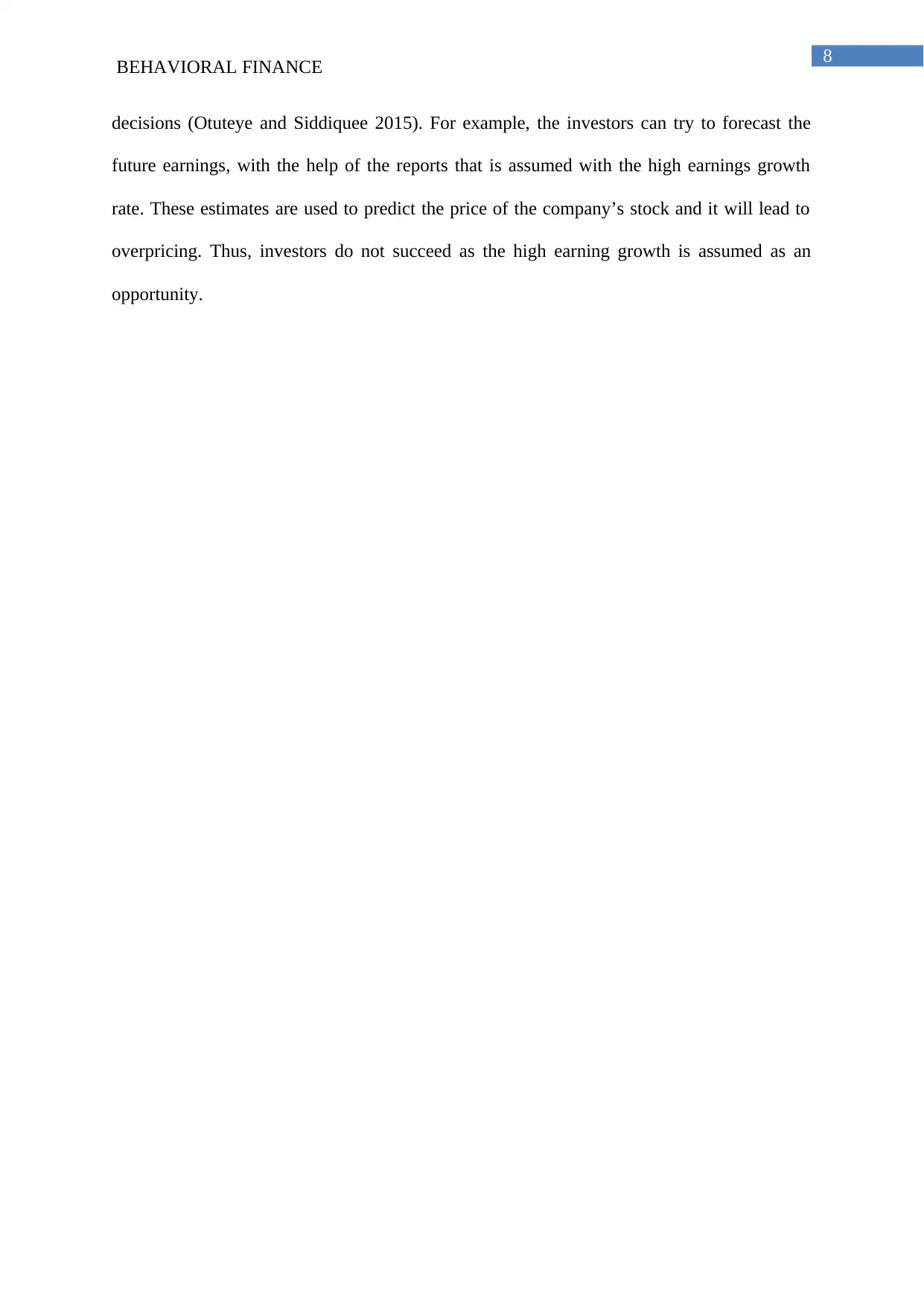
8
BEHAVIORAL FINANCE
decisions (Otuteye and Siddiquee 2015). For example, the investors can try to forecast the
future earnings, with the help of the reports that is assumed with the high earnings growth
rate. These estimates are used to predict the price of the company’s stock and it will lead to
overpricing. Thus, investors do not succeed as the high earning growth is assumed as an
opportunity.
BEHAVIORAL FINANCE
decisions (Otuteye and Siddiquee 2015). For example, the investors can try to forecast the
future earnings, with the help of the reports that is assumed with the high earnings growth
rate. These estimates are used to predict the price of the company’s stock and it will lead to
overpricing. Thus, investors do not succeed as the high earning growth is assumed as an
opportunity.
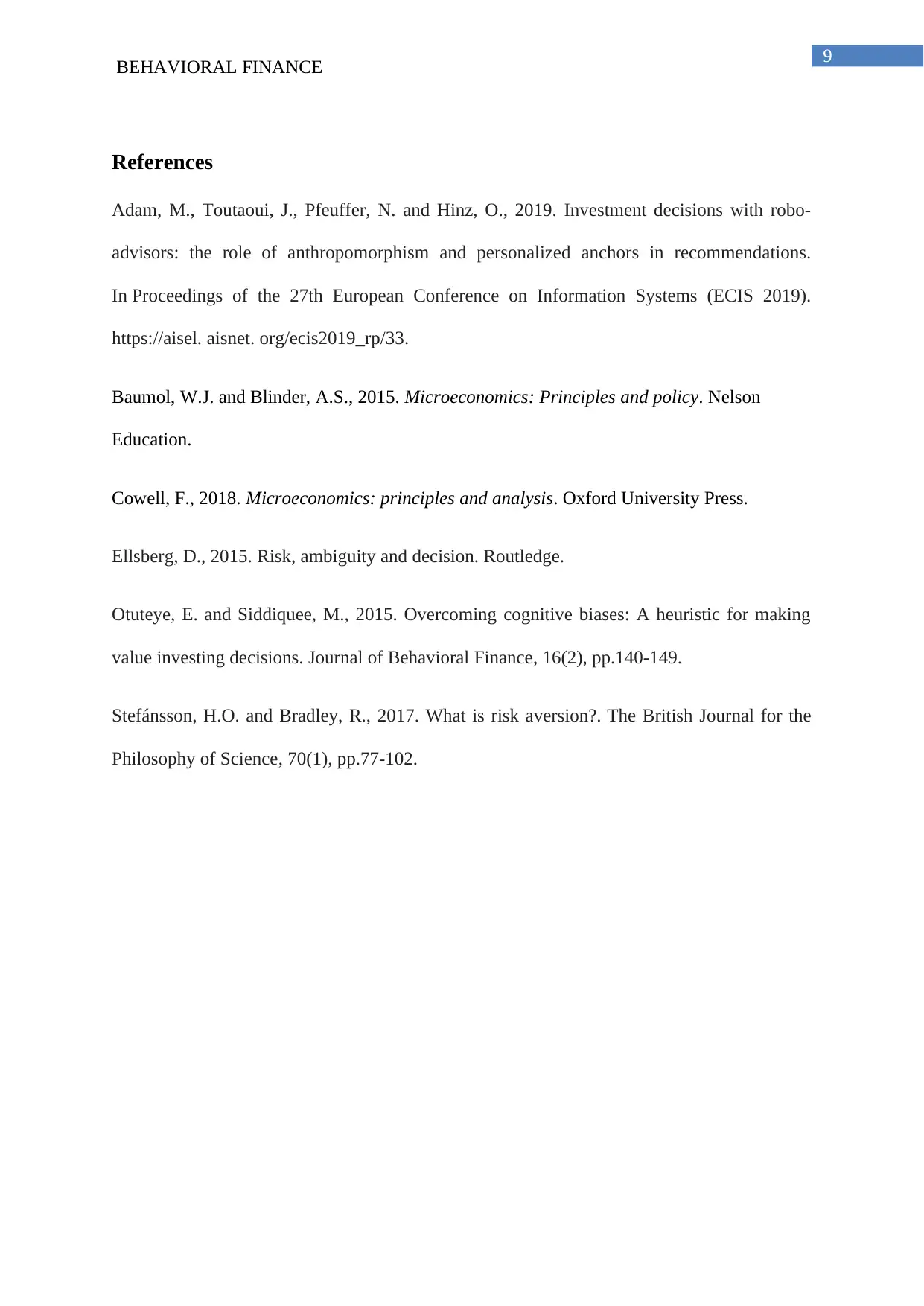
9
BEHAVIORAL FINANCE
References
Adam, M., Toutaoui, J., Pfeuffer, N. and Hinz, O., 2019. Investment decisions with robo-
advisors: the role of anthropomorphism and personalized anchors in recommendations.
In Proceedings of the 27th European Conference on Information Systems (ECIS 2019).
https://aisel. aisnet. org/ecis2019_rp/33.
Baumol, W.J. and Blinder, A.S., 2015. Microeconomics: Principles and policy. Nelson
Education.
Cowell, F., 2018. Microeconomics: principles and analysis. Oxford University Press.
Ellsberg, D., 2015. Risk, ambiguity and decision. Routledge.
Otuteye, E. and Siddiquee, M., 2015. Overcoming cognitive biases: A heuristic for making
value investing decisions. Journal of Behavioral Finance, 16(2), pp.140-149.
Stefánsson, H.O. and Bradley, R., 2017. What is risk aversion?. The British Journal for the
Philosophy of Science, 70(1), pp.77-102.
BEHAVIORAL FINANCE
References
Adam, M., Toutaoui, J., Pfeuffer, N. and Hinz, O., 2019. Investment decisions with robo-
advisors: the role of anthropomorphism and personalized anchors in recommendations.
In Proceedings of the 27th European Conference on Information Systems (ECIS 2019).
https://aisel. aisnet. org/ecis2019_rp/33.
Baumol, W.J. and Blinder, A.S., 2015. Microeconomics: Principles and policy. Nelson
Education.
Cowell, F., 2018. Microeconomics: principles and analysis. Oxford University Press.
Ellsberg, D., 2015. Risk, ambiguity and decision. Routledge.
Otuteye, E. and Siddiquee, M., 2015. Overcoming cognitive biases: A heuristic for making
value investing decisions. Journal of Behavioral Finance, 16(2), pp.140-149.
Stefánsson, H.O. and Bradley, R., 2017. What is risk aversion?. The British Journal for the
Philosophy of Science, 70(1), pp.77-102.
1 out of 10
Related Documents
Your All-in-One AI-Powered Toolkit for Academic Success.
+13062052269
info@desklib.com
Available 24*7 on WhatsApp / Email
![[object Object]](/_next/static/media/star-bottom.7253800d.svg)
Unlock your academic potential
© 2024 | Zucol Services PVT LTD | All rights reserved.




